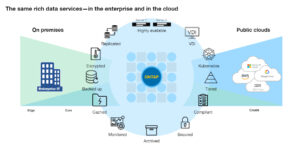


Today’s rapid changes in work and business priorities demand new levels of flexibility-especially when it comes to the applications that drive your business and their underlying infrastructure. Achieving flexibility means continually modernizing your infrastructure to better support your existing apps along with future cloud-native apps. It means using elastic clouds and storage resources to augment your on-premises footprint. With elastic storage, you can quickly and easily move data to wherever it needs to be-on premises, at the edge, or in a cloud-for better access by the users and applications that need it. If architected right, modern infrastructure that affords this flexibility offer great advantages to your business: the ability to move quickly, to compete better, and to pivot dynamically with change.
Yet managing applications and data across distributed environments, while also maintaining availability, resilience, performance, and security, isn’t a simple undertaking. Integrating diverse environments is complex, and can cause interoperability and management challenges that create operational risk.
NetApp® hybrid cloud solutions remove that complexity and risk, giving you the freedom to use the most appropriate resources at any point in time, regardless of physical location and cloud provider.
With this freedom, you can dynamically support your existing enterprise apps and new apps-all in the same integrated environment.
Constantly innovate. An agile hybrid cloud lets Siemens Healthineers’ developers access storage to speed up innovation. They expanded their data center to the cloud without refactoring or reducing application functionality.
Pivot quickly for competitive gain. Dow Jones created a hybrid environment to eliminate data silos and give stakeholders access to data when and where they need it. This environment helped them create game-changing customer experiences and boost competitive differentiation.
Respond to customers, and deliver new experiences, faster. Using a hybrid cloud to activate data from around the world helped Ducati optimize motorcycle performance and elevate its customer experience.
Make decisions faster. A hybrid cloud let Aston Martin integrate data from the trackside to factory-supporting faster, more confident decision making that translated to a winning edge on the track.
NetApp helps you build and evolve a unified hybrid cloud that seamlessly integrates your data center with your choice of public or private clouds. A unified hybrid cloud provides a common storage layer with a consistent set of tools and processes to manage, protect, and move your enterprise data and applications without requiring additional staff or skills. With NetApp’s application-driven infrastructure and capabilities, you’ll realize greater cost optimization, security, resilience, performance, and manageability across your entire footprint supporting all of your workloads.
NetApp ONTAP® data management software is the heart of the NetApp hybrid cloud. ONTAP gives you the same rich enterprise-grade data services on premises and in the cloud, for full interoperability and consistent data storage, management, and protection in any environment. It’s the only data management software running both on premises and natively in the world’s biggest clouds. Because ONTAP supports a hybrid cloud architecture that isn’t tied to a location or cloud vendor, you avoid cloud vendor lock-in and can move and store your data where needed. And ONTAP supports file, block, and object data storage, so it satisfies multiple use cases and enables application and data mobility with no refactoring or replatforming of applications.
 Simplified Data Management
Simplified Data ManagementNetApp provides a full suite of application-driven infrastructure and data management services to help you consistently manage, analyze, and optimize your data and underlying hybrid cloud infrastructure. These services provide a consistent approach to legacy, monolithic workloads as well as cloud-native and container-based workloads.
Infrastructure and data management. NetApp Cloud Manager provides a consistent way to manage, secure, and protect your data more efficiently across distributed hybrid cloud environments without the need for new skills or staff, while NetApp’s extensive set of APls let you automate infrastructure and application management by using your preferred automation and orchestration frameworks. Cloud Backup Service delivers seamless and cost-effective backup and restore capabilities for protecting and archiving cloud and on-premises ONTAP data.
Infrastructure analytics. NetApp artificial intelligence for IT operations (AIOps) tools create a more proactive, predictive environment, reducing administration and downtime costs. NetApp Active IQ® uses Al to proactively protect and optimize your infrastructure, and NetApp Cloud Insights gives you complete visibility into your infrastructure and applications. You can monitor, troubleshoot, and optimize all your resources and applications across your entire technology stack, whether it’s on premises or in the cloud. Cloud Secure, a feature of Cloud Insights, analyzes data access patterns to identify risks from ransomware attacks.
Data analytics. Driven by powerful Al algorithms, NetApp Cloud Data Sense (formerly Cloud Compliance) provides hybrid cloud and on-premises data discovery, mapping, and classification. It offers automated controls and reporting so that you can always stay on top of your data.
Optimization. Spot by NetApp is a cloud automation solution that uses advanced analytics to continuously optimize your cloud infrastructure resources.
Cloud-native application management. NetApp Astra provides application storage management and data provisioning for stateful cloud native applications powered by NetApp’s trusted data protection technology. Astra presents a consistent data management experience across a hybrid cloud.
|
![]()
Xigent’s partnership with NetApp focuses on enabling digital transformation for clients, accelerating their profitability, and providing a predictable and manageable business environment for their employees, end-users, and stakeholders alike. Additionally, they enable us to improve business outcomes for our clients long-term. We’re proud to be recognized as a NetApp Professional Services Certified partner – this provides industry validation of Xigent subject matter experts’ skills in administering superior NetApp services and products for maximum client satisfaction. NetApp’s commitment to being a visionary in our industry, their best-in-class support and consistent financial performance make them one of the most consistent and stable vendors in the data management industry.
Source: NetApp Hybrid Cloud Solution Brief 2021
Connect With a Hybrid Cloud Expert